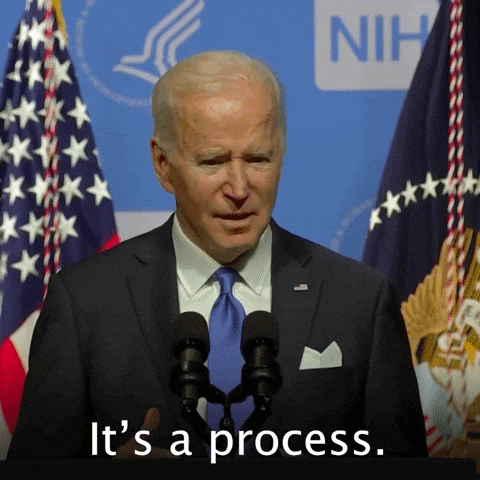- Buzz Boi
- Posts
- IPO Ka Funda - Aaasan Dhandha 😎.
IPO Ka Funda - Aaasan Dhandha 😎.
This Newsletter Is Present by
Hey Sis/Boi’s!👋
Han ji aapke bhi smajh me ye nahi aa raha hai, ki IPO ke picche ka fanda kya hai. Tab koi baat nahi hai, aaj aap isko samjhoge matra 5 minutes me. Aaaiye samajhte hain!
IPO (Initial Public Offering) ek aisa process hai jisme ek private company apne shares ko public ko bechne ke liye stock market me pehli baar list karti hai.
IPO ke zariye company public se paisa raise karti hai jise wo apne business ke growth , debt repayment, aur anya corporate purposes ke liye use kar sakti hai.

Giphy
Agar simple tarike se kaha jaye to ise ek example se samajhte hai,
Suppose that - x name ka ek aadmi hai jisne xyz name ki ek company 2018 me banayi jo ki sirf ek nation India me perform karta hai .
2018-2024 tak xyz company ka total value 200 crore ki hai . ab x chahta hai ki uski company ek nation se nikal kar dusre desho me v kam kare yani wo xyz ko international karna chahta hai jiske liye use 50 crore rupay ki jarurat hai.
iske liye x ko bank se loan lena parega lekin loan par use kafi jyada interest dena parega or bahut sare expenses hai.
is wajah se x loan na lekar apni company xyz ko share market me list karwa kar IPO release karke company ke share public ko bechega .
jis se public ka paisa direct X ke pas jayega. Un paiso ko wo xyz company ke growth me lagayega.
Is se public ka kya fayeda hoga? aage samajhte hai !!
IPO Ki Puri Process Ka Detailed Explanation -
Pre-IPO Planning -
Objective Setting: - Company pehle apne objectives decide karti hai ki IPO karne ka maksad kya hai. Yah capital raise karna ho sakta hai, business expansion ke liye ya debt repayment ke liye.
Financial Health Check: - IPO se pehle company apne financials ko achche se evaluate karti hai. Agar zaroorat pade to financial restructuring bhi kiya jata hai.
Corporate Governance: - IPO ke liye company ko apne governance structures ko strong banana padta hai. SEBI ke rules ke mutabik, board of directors me independent directors ka hona zaroori hai.
Hiring Advisors and Underwriters -
Merchant Bankers: - IPO process me ek merchant banker ko hire kiya jata hai jo IPO ka lead manager hota hai. Ye merchant bankers company ki financial health, market conditions, aur other factors ko analyse karke IPO ka price band aur quantity decide karne me madad karte hain.
Underwriters: - Underwriters woh financial institutions hote hain jo IPO ke shares ko buy karne ka commitment dete hain agar market me demand nahi bani to. Ye underwriters investors ko shares bechne ka guarantee dete hain.
Documentation -
Draft Red Herring Prospectus (DRHP): - IPO se pehle, company ko DRHP file karna padta hai jo SEBI ke approval ke liye diya jata hai. Is document me company ke financials, business model, risks, aur IPO ke terms and conditions ke bare me detail hoti hai.
Final Red Herring Prospectus (RHP): - SEBI ke approval ke baad, company final RHP issue karti hai jisme IPO ki actual dates, price band, aur other relevant details hoti hain.
Regulatory Compliance -
SEBI Approval: - IPO launch karne se pehle, SEBI (Securities and Exchange Board of India) ke approval ki zaroorat hoti hai. SEBI ensure karta hai ki company ka IPO process transparent aur investor-friendly ho.
Stock Exchange Approval: - IPO launch ke liye, company ko stock exchanges (jaise NSE ya BSE) se bhi approval lena padta hai. Stock exchange company ke credentials aur financials ko evaluate karta hai.
IPO Pricing -
Fixed Price IPO: - Company pehle se hi ek fixed price decide karti hai jisme investors shares kharidte hain.
Book Building Process: - Is process me, company ek price band decide karti hai (jaise Rs. 100-120 per share), aur investors apne bids us band ke andar lagate hain. Final price demand ke hisaab se decide hota hai.

Gif by TheDemocrats on Giphy
Marketing and Roadshows -
Investor Roadshows: - IPO launch se pehle, company apne IPO ko market karne ke liye various cities aur countries me roadshows conduct karti hai. Isme company ke senior management potential investors ko apne business ke bare me batate hain.
Marketing Campaigns: - IPO ko advertise karne ke liye TV, print media, digital platforms, aur other marketing channels ka use kiya jata hai.
IPO Launch and Subscription -
Subscription Period: - IPO ke launch hone ke baad, investors apne bids lagate hain. Ye process 3-5 din tak chal sakta hai. Retail investors, institutional investors, aur high net-worth individuals alag-alag quota me apne bids lagate hain.
Oversubscription/Undersubscription: - Kabhi-kabhi IPO ke shares ke liye demand bahut zyada hoti hai, jise oversubscription kehte hain. Is case me shares ka allotment proportionately hota hai. Agar demand kam hoti hai to undersubscription hota hai.
Allotment and Listing -
Share Allotment: - IPO ke close hone ke baad, company aur underwriters shares ka allotment karte hain. Successful bidders ke demat accounts me shares transfer kiye jate hain.
Stock Exchange Listing: - IPO ke baad, company ke shares stock exchange (NSE, BSE) me list hote hain. Listing ke din share ka trading shuru hota hai aur us din ka price movement kaafi important hota hai kyunki ye market sentiment ko reflect karta hai.
Post-IPO Phase -
Continuous Disclosure - IPO ke baad, company ko SEBI aur stock exchanges ke norms ke mutabik apne financials aur corporate developments ko publically disclose karna padta hai.
Price Fluctuation - IPO ke baad shares ka price market conditions, company ke performance, aur other macro-economic factors ke hisaab se fluctuate kar sakta hai.

Gif by cbc on Giphy
IPO Ke Fayde Aur Nuksan -
Fayde -
Capital Raising: - IPO ke zariye company bade amount me capital raise kar sakti hai jo expansion aur other corporate activities me use hota hai.
Brand Visibility: - IPO ke baad company ki public visibility aur credibility me badhotri hoti hai.
Liquidity: - Existing investors aur promoters apne shares ko bechkar liquidity achieve kar sakte hain.
Nuksan -
Market Volatility: - IPO ke baad shares ka price market volatility ke hisaab se kam ya zyada ho sakta hai.
Regulatory Burden: - Public company banne ke baad, company ko SEBI ke strict regulatory norms ko follow karna padta hai jo kaafi time-consuming aur costly ho sakta hai.
IPO Ka Historical Perspective -
IPO ek purani prakriya hai jiska origin 1600s me East India Company ke shares ke public offerings se hota hai. Bharat me IPO market 1990s me liberalization ke baad se tezi se grow hua hai.
Aaj ke samay me, IPOs ek major tool ban gaye hain companies ke liye capital raise karne ke liye aur investors ke liye wealth creation ke liye.
IPO ek significant financial event hota hai jo company ki future growth aur investors ke returns dono ko prabhavit karta hai.
Isliye IPO me invest karne se pehle investor ko company ke business model, financials, aur market conditions ko achhi tarah se evaluate kar lena chahiye.

Gif by bypriyashah on Giphy
Conclusion -
Kya ab aapko samajh aaye ya nahi ki ye IPO ke funda kya hai, ab ek request kar raha hun. Mera VISION hai ki jyada jyada logo ko apne plateform se jod pau.
Ab iske liye aapko hamara sath dena hoga, ye bilkul subscribe karna to abhi subscribe kar do aur doston se bhi karo yaar!

Reply